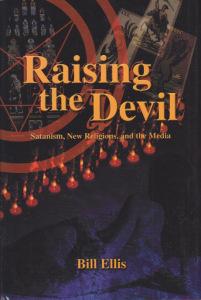 Once in a great while you read a book that has the potential to shift paradigms.The unusual and provocative Raising the Devil: Satanism, New Religions, and the Media, by Bill Ellis, is such a book.Perhaps the main reason for this is that Ellis is a folklore scholar who takes his subject seriously.He cites some unusual sources non-judgmentally, but critically.He suggests that folklore can actually dictate reality for its believers, while not demanding that it defines how everyone else sees the world.This fine parsing allows him to examine the satanic cult scares of the 1980s and ‘90s with a kind of passionate dispassion.He traces the historical contexts that made such panics possible, all the while keeping belief structures in place.In the end, the giving in to this folklore on the part of society can lead to tragic results.Understanding folklore might well prevent that.
Once in a great while you read a book that has the potential to shift paradigms.The unusual and provocative Raising the Devil: Satanism, New Religions, and the Media, by Bill Ellis, is such a book.Perhaps the main reason for this is that Ellis is a folklore scholar who takes his subject seriously.He cites some unusual sources non-judgmentally, but critically.He suggests that folklore can actually dictate reality for its believers, while not demanding that it defines how everyone else sees the world.This fine parsing allows him to examine the satanic cult scares of the 1980s and ‘90s with a kind of passionate dispassion.He traces the historical contexts that made such panics possible, all the while keeping belief structures in place.In the end, the giving in to this folklore on the part of society can lead to tragic results.Understanding folklore might well prevent that.
Since our prevailing cultural paradigm is a materialism based on empirical observation, at least among those deemed “educated,” it is easy to lose track of how belief constructs our worlds.Ellis finds the cradle of satanic panics in the Pentecostal tradition where deliverance ministry—a Protestant form of exorcism—takes seriously the belief in demons of many kinds.This leads to a study of ouija boards and Spiritualism.Although neither led to Pentecostal theology, both play into it as doorways for demonic activity, in that worldview.Add into this dissociative identity disorder (what used to be called, and what Ellis refers to as “multiple personality disorder”) and the recipe for a spiritual mulligatawny is simmering away.You need not believe what the victim says, but if s/he believes, you must pay attention.
Outside the strict confines of Satanism, other cultural phenomena allowed for panics to grow.Popular narratives, largely false, of satanists cum evangelists (think Mike Warnke) mingle with cultural fears such as the Highgate Vampire scare and cattle mutilations to make a narrative of satanic ritual abuse believable.A folklorist sees the connections that a strictly wielded razor by Occam tries to shave away.All of this fits together.When we don’t pay attention to how real this is to those involved, a half-baked public panic can erupt.Ellis suggests such circumstances might well have led individual witch hunts into large-scale witch crazes.While both are unfortunate, the latter tend to lead to many, many ruined lives.The subtle awareness that one need not believe in order to understand those who do is something worth pondering.Reality may be far more complex than the activity of electro-chemical signals in a strictly biological brain after all.
